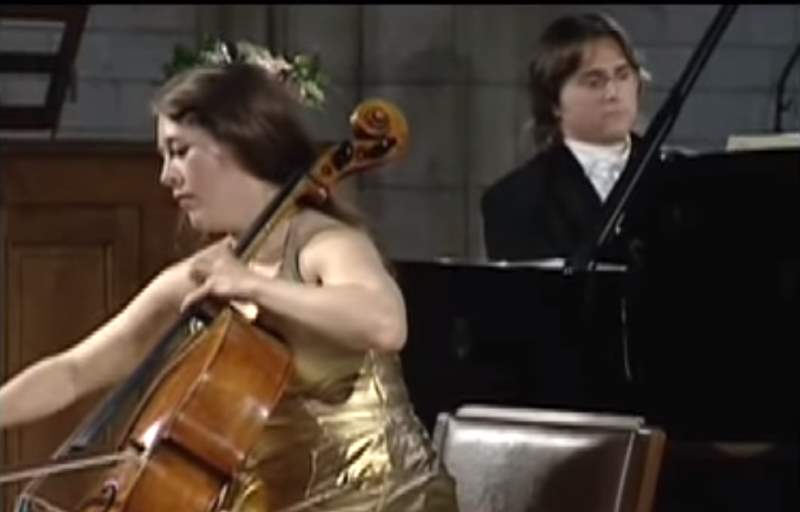Georgian classical pianist Khatia Buniatishvili performs Liebesträume No. 3 (Liebesträume means “Dreams of Love” in English), the third of a set of three solo piano works (S.541/R.211) by Franz Liszt. This performance was recorded during the 2011 Verbier Festival.
Pianist Khatia Buniatishvili, born in 1987 in Tbilisi/Georgia, was considered a wunderkind as a child. She began playing piano at the age of three, giving her first concert with the Tbilisi Concert Orchestra at age six. International performances followed from the age of ten. In 2008, she made her US debut in New York’s Carnegie Hall. Since then, Buniatishvili has been regularly invited to many high-profile festivals and has performed concerts in the world’s most renowned concert halls, including Vienna’s Musikverein, the Concertgebouw in Amsterdam, and the Berlin Philharmonic. She has twice received the highly respected Echo Classic Award.
The Verbier Festival is one of the world’s most prestigious classical music events. The quality of participating artists – coupled with the originality of the programs – has established the festival as a highlight of the musical calendar. It is held for two weeks – from late July to early August – in the mountain resort of Verbier, Switzerland.
Franz Liszt’s Liebesträume No. 3
Franz Liszt’s “Liebesträume No. 3” is a piece that beautifully encapsulates the romantic spirit of the 19th-century piano repertoire. Composed around 1850, this piece is the most famous of the three Liebesträume (“Dreams of Love”). Liszt, a Hungarian composer and virtuoso pianist, was known for his remarkable ability to blend technical prowess with deep emotional expression, and “Liebesträume No. 3” is a prime example of this.
The piece is in A-flat major, a key often associated with warm and affectionate emotions in the romantic music era. It starts with a gentle, flowing melody that is both lyrical and poignant. This melody sets the stage for the entire piece, embodying a sense of longing and unfulfilled passion. The structure of “Liebesträume No. 3” is relatively straightforward, following a simple ABA format, but what makes it stand out is Liszt’s use of rich harmonies and intricate arpeggios that give the piece its lush and dreamy quality.
Technically, the piece is demanding, requiring a pianist to have great control over dynamics and phrasing. The middle section shifts to a more turbulent mood, reflecting a kind of passionate struggle or longing. This contrasts with the tender and more introspective opening and closing sections. The piece concludes with a reiteration of the initial theme, but this time it’s more subdued and reflective as if resigning to the dreamlike state of love.
Liszt was inspired by the poetry of Ludwig Uhland and Ferdinand Freiligrath, from which the title “Liebesträume” comes. The poems speak of love and death, and Liszt’s musical interpretation is a reflection of these themes, translating the poetic emotions into musical language.
“Liebesträume No. 3” holds a special place in the piano repertoire, beloved by audiences for its emotional depth and by pianists for its technical and expressive challenges. It’s a testament to Liszt’s genius in bridging the virtuosic and the poetic, making him one of the most celebrated composers of the Romantic era.
In the context of Liszt’s broader work, “Liebesträume No. 3” represents his dual identity as a virtuoso and a poet of the piano. While his earlier compositions often focused on dazzling technical displays, his later works, including the Liebesträume, reveal a more introspective and expressive side. This piece, therefore, is not just a display of pianistic skill but also an exploration of deep emotional landscapes.
Regarding its impact, “Liebesträume No. 3” has influenced both classical and popular music. Its melody has been adapted in various forms, and its romantic themes resonate with listeners even today. It’s a piece that not only showcases the technical capabilities of the piano but also the instrument’s ability to convey profound human emotions.
Franz Liszt’s “Liebesträume No. 3” is a masterpiece of romantic piano music, blending technical mastery with deep emotional expression. Its enduring popularity is a testament to its ability to touch the hearts of listeners and its significance in the repertoire of classical piano music.
Sources
- Liebesträume on Wikipedia

